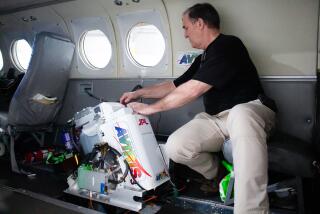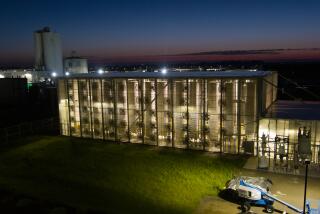High on Light
EDWARDS AIR FORCE BASE — The early development of Centurion--NASA’s super-light, solar-powered airplane that makes its public debut Thursday--sounds like the plot line of an “X-Files” episode.
In the early 1980s, an aviation company located in a Simi Valley industrial park got a government contract to design and build a pilotless aircraft with a wingspan nearly the length of a football field. The aircraft was to be capable of climbing 20 miles above the Earth’s surface and then, powered only by the sun, be able to stay there for weeks or even months at a time.
It was an intriguing project for the engineers, but also mysterious. Company executives gave them no idea what the intended purpose of the aircraft was. The engineers didn’t even know which government agency had commissioned it.
“It was a secret, very secret program,” said Bob Curtin, an engineer on the original design team at AeroVironment, a company known for designing innovative, lightweight aircraft.
“To this day, I don’t know where the order came from.”
The prototype, called Pathfinder, got off the ground but failed to meet the mysterious buyer’s specifications. When the program was canceled, Pathfinder was hauled away. Curtin didn’t know where it was taken, or even if it was kept intact.
Until 1994.
That’s when the company received another government contract to build a solar-powered airplane. Pathfinder, which had been kept in storage somewhere, was delivered back to the Simi Valley industrial park.
“The idea,” Curtin said, “was to see if, with ‘90s technology, the project could be updated.”
This time, however, the project was not kept secret for long. The time had come, in this “X-Files” story, for a commercial break.
Easier to Fix Than a Satellite
The current sponsor of the project is NASA, which is now ruled by an edict that programs should, whenever possible, pay for themselves. Far from wanting to keep Centurion, the direct descendant of Pathfinder, a secret, the agency wants entrepreneurs and business people worldwide to know of its existence.
The agency believes that solar-powered airplanes--if proved successful at long-term, high-altitude flights--could do many tasks now performed by satellites, including communications.
“We could park an airplane over a city where it could do the same work as a communications satellite in relaying telephone calls, television signals, all kinds of data,” said John Del Frate, project manager for NASA’s solar aircraft program. “But the clear advantage is that, if something goes wrong with equipment on an airplane, you can bring it down and fix it. That’s not so easy to do with a satellite.”
Solar-powered airplanes could also, he said, encourage the use of cutting-edge technologies.
“If you come up with something new in communications satellites now, it takes three or four years before you get it on a launch,” Del Frate said. “But the cost effectiveness of these aircraft would be such that we could take green technology, the latest, and get it up there.”
The project has a long way to go before proving itself commercially viable, however, Del Frate said.
Pathfinder lived up to its name, when the solar-powered aircraft project was revived in the 1990s, initially by the Department of Defense. “They were looking for a vehicle that could provide surveillance of trouble areas,” said Curtin, who is still with AeroVironment, and now oversees the project.
With cutting-edge upgrades to the aircraft’s motors, solar cells and storage batteries, Pathfinder was much improved. But after several encouraging low-altitude flights, the Department of Defense pulled out. The agency’s division that had sponsored the Pathfinder revival--the Ballistic Missile Defense Office--had lost its funding.
NASA stepped in, and a second, larger Pathfinder was built for high-altitude testing. Last year, it reached just over 80,200 feet--more than 15 miles--the highest altitude ever for a propeller-driven aircraft.
But this Pathfinder, with its wingspan of 121 feet, was not long enough to achieve the ultimate goal--sustained flight at 100,000 feet.
Using lessons learned from Pathfinder, AeroVironment built Centurion, which has a wingspan of 206 feet.
If looks alone could win this technology race, Centurion would surely be a winner. Basically, it’s one long, gracefully arched wing, covered in sheer plastic through which its carbon fiber struts can be seen. Fourteen gray propellers mounted on the wing provide propulsion and give the aircraft a retro look that is not inappropriate.
“It’s the basics of flight,” Del Frate said. “After all these years of jets and rockets, we’re back to an aircraft that looks an awful lot like what the Wright brothers built.”
High Hopes, but Low Beginnings
On Tuesday, Centurion was taken out of its hangar at Edwards for its first flight, which went only as high as 300 feet. The aircraft was remote-controlled by a “pilot” who sat in front of a computer mounted on a van on a runway.
“The flight was uneventful, and that’s a good thing,” Del Frate said. “We don’t like surprises.”
Outsiders were not invited for the event, but the flight didn’t escape notice from the base’s workers, most of whom are not involved with the project. “Everyone was coming out of their offices to see this thing fly,” Del Frate said.
Currently, Centurion’s power comes from battery packs mounted on its four sets of landing gear. Eventually, if initial flights succeed, the power will come from rows of solar panels atop the wing.
The cost of the panels is considerable--an estimated $7 million, which is almost equal to the entire amount that has been spent on Centurion so far, according to NASA. (Because the Pathfinder project went through numerous stages over a number of years, its total cost has not been calculated, agency officials said.)
The ultimate goal for Centurion is to reach an altitude of 100,000 feet and remain there for several hours. But even if development goes smoothly, this can’t be achieved until at least 2002. “The funds to get us that far aren’t available all at once, so we have to add onto the project as the funding comes in,” Del Frate said.
If All Goes Well, Helios Is Next Step
After Centurion would come the final phase of the program, Helios. As now planned, this aircraft will have a wingspan of about 250 feet and will be equipped with solar batteries to provide power for night flight.
But for the immediate future, those involved in the program are concentrating on Centurion’s second flight Thursday, weather permitting. The plan is for another short flight to reach about 300 feet, but this time there will be an outside audience, the media.
It will be a key moment. More than one high-tech program has been set back or even scrubbed after a public failure.
Is Del Frate nervous?
“I don’t really get all that nervous just before takeoff,” he said. “Sure, the adrenaline is running, but I’m pretty confident in the design.”
Then he laughed.
“To be honest, I’m perfectly fine until just before the landing. That’s what really gets me.”
(BEGIN TEXT OF INFOBOX / INFOGRAPHIC)
NASA’s New Slow, High Flier
Centurion is a pilotless aircraft with a long wingspan that NASA plans to cover with solar cells to power long flights 20 miles above Earth.
Centurion wingspan: 206 ft.
Boeing 747 wingspan: 195 ft. 8 in
*
Aircraft Specifications
Wingspan: 206 ft.
Length: 12 ft.
Wing area: 1,648 sq. ft.
Empty weight: Approx. 1,175 lbs.
Airspeed: 17-21 mph.
Source: Jane’s Aircraft Recognition Guide; NASA
More to Read
Inside the business of entertainment
The Wide Shot brings you news, analysis and insights on everything from streaming wars to production — and what it all means for the future.
You may occasionally receive promotional content from the Los Angeles Times.











